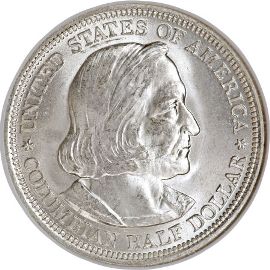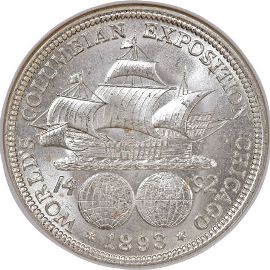Columbian Exposition Half Dollar

The Columbian Exposition Half Dollar was the first Classic Commemorative Half to be made. The coins were produced in 1892 and 1893 to commemorate the 400th anniversary of Christopher Columbus’s voyage to the New World. Another well known coin made to commemorate this event was the Isabella quarter.
The act that authorized these coins stipulated that the silver used in making them must be derived from melted obsolete US coins. Half Dimes, Quarters, Silver Dollars, and many other denominations went to the melting pot to create them. I’m

sure many rare coins were lost forever because of this!
These coins have always been very popular with collectors. The very first coin was bought for $10,000 as a publicity stunt by the company that made Remington typewriters. Since then, this commemorative half has enjoyed its place in many numismatic collections.
On the obverse of the coin is a portrait of Christopher Columbus. The inscriptions that surround the portrait read "UNITED STATES OF AMERICA" and "COLUMBIAN HALF DOLLAR". The image of Columbus
was based on a portrait by Lawrens
Lotto in 1512.
The reverse depicts an image of the Santa Maria. This was Columbus’s main ship he used in his voyage to the New World. The reverse also shows two globes under the ship. Inscriptions on the reverse read "WORLDS COLUMBIAN EXPOSITION CHICAGO" and the date "1892" around the outer part of the coin.
The vast majority of these coins were mishandled therefore lowering the grade of the coin. These coins are fairly common in lower grades due to the fact that a good percentage of them ended up in circulation. A lot of these coins were stored in bank vaults for years. It would not surprise me to find one in an old Half Dollar bank roll. The hunt is on!
Dates Minted: 1892-1893
Authorization: Act of Aug 5th, 1892
Authorized mintage: 1892 - 950,000 & 1893 - 4,052,105
Actual distribution: 1892 - 950,000 & 1893 - 1,548,300
Designer: Obv - Charles Barber & Rev - George T Morgan
Weight: 12.5g
Composition: 90% Silver, 10% Copper
Diameter: 30.6mm
Back to Coin Collecting Homepage


